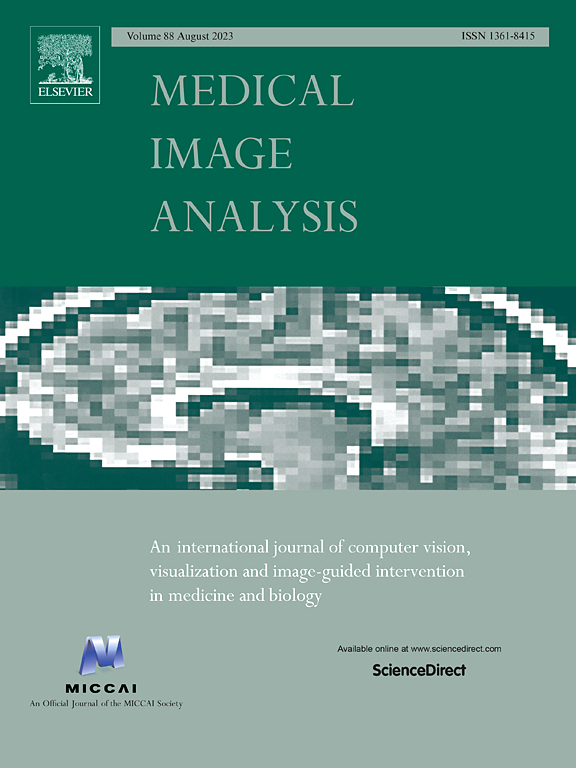翻转学习:弱监督擦除分割乳腺超声结节
IF 10.7
1区 医学
Q1 COMPUTER SCIENCE, ARTIFICIAL INTELLIGENCE
引用次数: 0
摘要
二维乳腺超声(BUS)和三维自动乳腺超声(ABUS)对结节的准确分割对临床诊断和治疗计划至关重要。因此,开发一个自动化的结节分割系统可以提高用户的独立性,加快临床分析。与完全监督学习不同,弱监督分割(WSS)可以简化费力而复杂的注释过程。然而,目前的WSS方法在实现精确的结节分割方面面临挑战,因为许多方法依赖于不准确的激活图或低效的伪掩码生成算法。在本研究中,我们引入了一种新的基于多智能体强化学习的WSS框架,称为翻转学习,该框架仅依赖于2D/3D盒子进行准确分割。具体而言,使用多个代理从盒子中擦除目标,以方便分类标签翻转,擦除的区域作为预测的分割掩码。本研究的主要贡献如下:(1)采用基于超像素/超体素的方法对标准化环境进行编码,捕获边界先验,加快学习过程。(2)引入三种精心设计的奖励,包括一个分类分数奖励和两个强度分布奖励,以精确地引导agent的擦除过程,从而避免分割不足和分割过度。(3)实施渐进式课程学习策略,使智能体以渐进式挑战的方式与环境互动,从而提高学习效率。在大型内部BUS和ABUS数据集上进行了广泛的验证,我们的翻转学习方法优于最先进的WSS方法和基础模型,并实现了与全监督学习算法相当的性能。本文章由计算机程序翻译,如有差异,请以英文原文为准。
Flip Learning: Weakly supervised erase to segment nodules in breast ultrasound
Accurate segmentation of nodules in both 2D breast ultrasound (BUS) and 3D automated breast ultrasound (ABUS) is crucial for clinical diagnosis and treatment planning. Therefore, developing an automated system for nodule segmentation can enhance user independence and expedite clinical analysis. Unlike fully-supervised learning, weakly-supervised segmentation (WSS) can streamline the laborious and intricate annotation process. However, current WSS methods face challenges in achieving precise nodule segmentation, as many of them depend on inaccurate activation maps or inefficient pseudo-mask generation algorithms. In this study, we introduce a novel multi-agent reinforcement learning-based WSS framework called Flip Learning, which relies solely on 2D/3D boxes for accurate segmentation. Specifically, multiple agents are employed to erase the target from the box to facilitate classification tag flipping, with the erased region serving as the predicted segmentation mask. The key contributions of this research are as follows: (1) Adoption of a superpixel/supervoxel-based approach to encode the standardized environment, capturing boundary priors and expediting the learning process. (2) Introduction of three meticulously designed rewards, comprising a classification score reward and two intensity distribution rewards, to steer the agents’ erasing process precisely, thereby avoiding both under- and over-segmentation. (3) Implementation of a progressive curriculum learning strategy to enable agents to interact with the environment in a progressively challenging manner, thereby enhancing learning efficiency. Extensively validated on the large in-house BUS and ABUS datasets, our Flip Learning method outperforms state-of-the-art WSS methods and foundation models, and achieves comparable performance as fully-supervised learning algorithms.
求助全文
通过发布文献求助,成功后即可免费获取论文全文。
去求助
来源期刊

Medical image analysis
工程技术-工程:生物医学
CiteScore
22.10
自引率
6.40%
发文量
309
审稿时长
6.6 months
期刊介绍:
Medical Image Analysis serves as a platform for sharing new research findings in the realm of medical and biological image analysis, with a focus on applications of computer vision, virtual reality, and robotics to biomedical imaging challenges. The journal prioritizes the publication of high-quality, original papers contributing to the fundamental science of processing, analyzing, and utilizing medical and biological images. It welcomes approaches utilizing biomedical image datasets across all spatial scales, from molecular/cellular imaging to tissue/organ imaging.
 求助内容:
求助内容: 应助结果提醒方式:
应助结果提醒方式:


